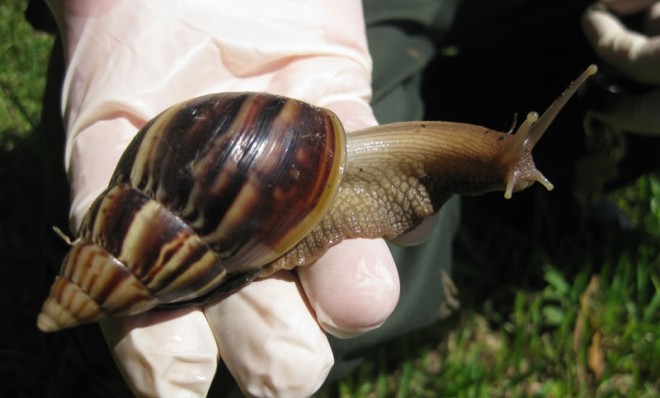WATCH: The giant, rat-sized snails devouring South Florida
The giant African land snail can grow to 8 inches long, eat through plaster, and puncture your car tire


South Florida is under attack, and the non-native species threatening to wreak havoc seems innocent enough: It's not the giant Burmese pythons that made a home in the Everglades in 2000, nor a ravenous, land-walking fish like the Asian carp that have been eating through waterways farther up north.
No, this foreign invader is a snail.
But what a snail it is. The giant African land snail "can grow as big as a rat and gnaw through stucco and plaster," says Reuters' Barbara Liston. Since the monstrous mollusks were first noticed in the Miami-Dade County area in September 2011, researchers and vigilant homeowners have caught at least 117,000 of them, or about 1,000 a week. And "residents will soon likely begin encountering them more often, crunching them underfoot as the snails emerge from underground hibernation at the start of the state's rainy season in just seven weeks."
The Week
Escape your echo chamber. Get the facts behind the news, plus analysis from multiple perspectives.

Sign up for The Week's Free Newsletters
From our morning news briefing to a weekly Good News Newsletter, get the best of The Week delivered directly to your inbox.
From our morning news briefing to a weekly Good News Newsletter, get the best of The Week delivered directly to your inbox.
Just how big and bad are these slow-moving menaces? "The largest stretch 8 inches," says Zack Peterson in the Ocala StarBanner. "The oldest live nine years. The busiest lay up to 1,200 eggs" a year. They eat at least 500 species of plants, plus the stucco and plaster that provide calcium for their shells. And if that's not disturbing enough, the snails "even carry a parasitic nematode that can lead to meningitis in humans" — though no cases of the pathogen, rat lungworm, have been found among humans in the U.S. yet. (Watch raw footage of the snails below.)
They sound like "monsters from hell sent to punish us," or at least Florida, says Michael Ballaban at Jalopnik. But "perhaps the worst part of the invading monster snails is that if you hit one on the highway their shells are hard enough to cause a blowout." They can also turn deadly when a lawnmower hits one, flinging the shell out at high velocity. And then there's the slime trails they leave everywhere. "It becomes a slick mess," Denise Feiber, a spokeswoman for the Florida Department of Agriculture and Consumer Services, tells Reuters.
This isn't Florida's first battle with the giant African land snail. The Sunshine State won the last war — in the 1960s, after a boy brought three snails home from Hawaii — but it wasn't cheap or easy. Those three snails turned to 17,000 in seven years, and beating them took 10 years and $1 million. "Feiber said she doesn't want this eradication project to last that long," reports the StarBanner's Peterson. So last week, her department held a strategy roundtable with experts from across the U.S. and Canada.
How did this invasion start? "One possibility being examined is a Miami Santeria group, a religion with West African and Caribbean roots, which was found in 2010 to be using the large snails in its rituals," says Retuers' Liston. Or somebody could have brought them in as pets, like in 1966. Or it could have just been an accident, like this decidedly unsavory possibility:
A free daily email with the biggest news stories of the day – and the best features from TheWeek.com
"If you got a ham sandwich in Jamaica or the Dominican Republic, or an orange, and you didn't eat it all and you bring it back into the States and then you discard it, at some point, things can emerge from those products," Feiber said. [Reuters]
Miami-Dade is ground zero, but "unfortunately, the invasion is not limited to Florida," says Josh Mogerman in the Chicagoist. These "ticking environmental time bombs" have been found in upper Midwestern schools, pet shops, and even one private breeder's operation. And it would only take one escaped or released snail to spark a new infestation, Feiber tells Reuters:
They're huge, they move around, they look like they're looking at you... communicating with you, and people enjoy them for that.... But they don't realize the devastation they can create if they are released into the environment where they don't have any natural enemies and they thrive. [Reuters]
Peter has worked as a news and culture writer and editor at The Week since the site's launch in 2008. He covers politics, world affairs, religion and cultural currents. His journalism career began as a copy editor at a financial newswire and has included editorial positions at The New York Times Magazine, Facts on File, and Oregon State University.
-
 Europe sets 2027 deadline to wean itself from Russian natural gas
Europe sets 2027 deadline to wean itself from Russian natural gasIN THE SPOTLIGHT As international negotiators attempt to end Russia’s years-long invasion of Ukraine, lawmakers across the EU have reached a milestone agreement to uncouple the continent’s gas consumption from Moscow’s petrochemical infrastructure
-
 Benin thwarts coup attempt
Benin thwarts coup attemptSpeed Read President Patrice Talon condemned an attempted coup that was foiled by the West African country’s army
-
 Trump’s Comey case dealt new setback
Trump’s Comey case dealt new setbackspeed read A federal judge ruled that key evidence could not be used in an effort to reindict former FBI Director James Comey


